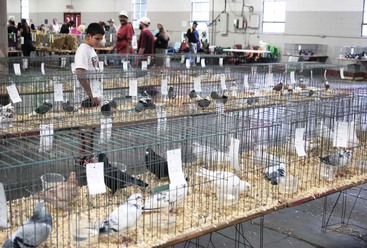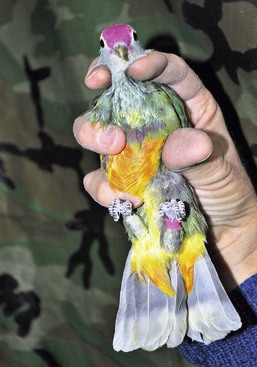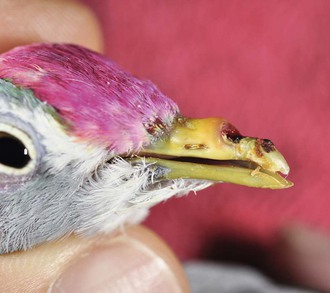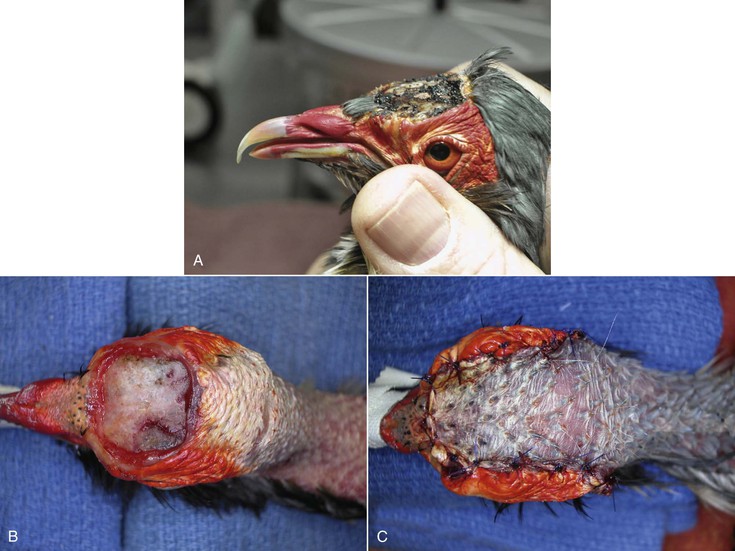Zoltan S. Gyimesi The order Columbiformes comprises a single family (Columbidae), which includes over 40 genera and 300 species of extant pigeons and doves. The term “pigeon” is typically used for larger species, whereas the term “dove” applies to most of the smaller species, although these terms may be interchangeable. Pigeons are believed to be the earliest domesticated avian species and have been used as a source of meat and fertilizer, as a method of long distance communication prior to the telegraph, and as a laboratory animal.28,34 Domestic columbids, including homing or racing pigeons, and the many varieties kept for exhibition and hobby (Figure 20-1) are descendants of the “urban pigeon” or rock dove (Columba livia). Columbiformes species have a widespread distribution found on every continent except Antarctica. Although many species are quite numerous, some of the populations inhabiting small islands are in danger of extinction. The dodo (Raphus cucullatus) and the passenger pigeon (Ectopistes migratorius) are two well-known Columbiformes species that have been driven to extinction by human activity. Pigeons and doves are typically tree-dwelling species, but some cliff-dwelling and ground-dwelling species occur as well. Tropical fruit doves spend most of their time in trees, feeding, roosting, and nesting there, and many other species nest in trees but forage on the ground. Rock doves in cities have adapted to using man-made structures such as buildings and bridges for roosting and nesting. Pigeons and doves have plump, stocky bodies, small heads and beaks, and relatively short legs and necks. They stand on anisodactyl feet (three toes forward, one toe backward). They are heavily feathered and lack a lateral cervical apterium (featherless tract), which complicates jugular venipuncture. Some tropical species are brilliantly colored or have ornamental crests or eye rings, but most pigeons and doves have more muted gray or brown coloring, perhaps with some iridescence. Males are generally larger, but gender determination may be challenging without DNA or laparoscopic sexing, as most species lack sexual dimorphism. Pigeons and doves tend to display a simple song and exhibit a wide range of soft calls and coos. They possess a fleshy cere, and the beak is not hard or powerful. The uropygial gland is either rudimentary or absent. Waterproofing and maintenance of plumage relies on powder from specialized feathers distributed via preening.31,34 Pigeons and doves have a prominent crop. Under the influence of prolactin, hyperplasia of the crop mucosa, with subsequent crop milk production, occurs in both males and females during brooding and raising of squabs. Crop milk is a cheesy, semi-solid, nutritious substance derived from desquamated crop epithelial cells. A vascular plexus in the cervical skin, from the cranium to the crop, has numerous functions such as sexual and territorial display, thermoregulation, and possibly facilitation of nutrient and enzyme deposition during lactation.31,34 The gizzard, or ventriculus, is muscular and harbors ingested grit in granivorous species but is less muscular, more saccular, and typically devoid of grit in specialized frugivores. Ceca are highly rudimentary in columbids, and a gall bladder is absent in many genera but present in others, including Ptilinopus, Ducula, and Gymnophaps.14 Columbids possess a long keel that supports a well-developed pectoral muscle mass, allowing for their characteristic explosive flight when taking off. Although many of the temperate species are cold hardy and may be housed outdoors year round in most climates, tropical columbids require indoor housing, at least during the cold season. Studies suggest that tropical fruit doves have a lower basal metabolic rate compared with other birds, including granivorous columbids, and are more intolerant of temperature extremes.30 All columbids require shelter and protection from predators, including raptors, terrestrial carnivores, rats, and feral dogs and cats. Hobbyists typically maintain domestic pigeons in protected lofts that vary in design, depending on the particular requirements of the pigeon variety and the number of birds housed. Breeds kept for their flying abilities need ample room to fly freely to maintain physical conditioning and fitness. Despite being a peace symbol, columbids are not docile and may be intolerant of conspecifics or other species. Aviaries should be well planted to offer cover and visual barriers, and ample roosting sites should be provided. A variety of natural perching is ideal. New groups of columbids should be closely monitored for signs of aggression. Overcrowding may lead to stress and disease. Favored roosting areas should be identified, and attention should be given to the subsequent accumulation of feces below these sites. If breeding is desired, a variety of species-appropriate nesting opportunities should be provided. Enclosures should be well ventilated but not drafty. Flooring may be concrete in off-exhibit holding pens or consist of a variety of natural substrates such as soil, mulch, and gravel in zoo exhibits. Columbids enjoy bathing in shallow water, so enclosures should include a suitable water feature. Particularly sensitive or wary species, newly acquired birds in quarantine, or columbids in off-exhibit breeding programs may benefit from more privacy; sheeting hung outside their aviary functions as an effective visual barrier to foot traffic. Similarly, padded ceilings, when feasible in smaller aviaries, decrease the risk of head trauma when birds startle and fly upward. In nature, pigeons and doves feed on a wide variety of vegetable matter, with seeds, legumes, fruits and berries, young leaves, buds, and flowers forming most of the diet.28,31,34 Invertebrates such as insects, snails, and earthworms are occasionally consumed, particularly by ground-foraging species. Granivorous pigeons will find seeds by flicking extraneous material out of the way with their beak and swallowing seeds whole. Fruit doves are highly arboreal, capable of clinging tightly to branches as they forage and reach to pluck bite-sized morsels of food. Rock doves may be agricultural pests, but other columbid species play important roles in the dispersal of the seeds of fruiting plants.37 In contrast to most birds that need to take in water and throw their heads back to swallow, pigeons and doves drink actively via suction by placing their beak in water up to their nares. In captivity, granivores should be provided an appropriate, commercially available avian crumble or pellet. Columbids do not typically eat finely ground feeds. When necessary, birds may be conditioned to eat pellets by soaking them in fruit juice or offering a formulation that is brightly colored. Pelleted feeds are often combined with a variety of seeds and legumes, diced vegetables and fruit, and cultivated insects. Complete formulated diets are readily available for domestic pigeons, and nutritional requirements have been reported elsewhere.29,31,34 For frugivorous doves, a higher proportion of chopped fruits and berries are offered. The fruit dove diet may also be supplemented with nectar. Species more prone to iron overload may benefit from a ration lower in iron and vitamin C and supplemented with dietary tannins. Husbandry staff should be aware that captive fruit doves have a tendency to accumulate soft foods on the beak and feathers around the mouth. Rations may need to be fortified with vitamin and mineral supplements, particularly calcium, as seed, fruit, and insect diets are typically not complete in themselves. Multiple feeding stations should be offered at various perch levels, even on the floor if necessary, to allow subordinate animals to feed. Positioning food and water bowls under roosting sites should be avoided. Food bowls may be swarmed by ants in aviaries and may impact feeding. This may be managed with shallow water moats and pest control practices. Exotic pigeons and doves maintained in large aviaries may be conditioned to feed at food stations within smaller catch pens to facilitate trapping. Birds in small pens or aviaries may be captured for examination by using soft mesh nets. Dimming the lights prior to capture may decrease panic and “fright flights” and facilitate a smoother, safer catch. Exotic pigeons and doves have a tendency to drop contour feathers as an adaptation to avoid capture by a predator. Quick, decisive captures, covering the head, and using a soft towel will decrease struggling, and minimize the risk of injury and feather loss. The wings should be folded and secured close to the body during manual restraint and examination (Figure 20-2). The duration of restraint events should be minimized. Placing columbids in padded, darkened crates is ideal for birds in need of being transferred to other locations. Capture and handling of domestic varieties are typically easier on both the handler and the bird, as they tend to be more accustomed to close observation and manual manipulation. The beak and feet of columbids do not pose a danger to handlers. As in most avian species, inhalant anesthetic agents such as isoflurane or sevoflurane via a non-rebreathing system are preferred for induction and maintenance of general anesthesia. Prior to certain procedures, a surgical plane of anesthesia should be reached, as painful stimuli may induce powerful wing flapping that risks injury to the bird. As with other birds, respiratory rate and depth must be constantly monitored. For surgical procedures, endotracheal intubation is recommended to better control the airway. With small patients, clinicians should be mindful of kinking or obstruction of the endotracheal tube lumen by secretions or lubricant. Injectable protocols are rarely indicated but ketamine at 20 to 50 milligrams per kilogram (mg/kg), alone or combined with diazepam (0.5–1.0 mg/kg) or xylazine (2.0 mg/kg), intramuscularly (IM), intravenously (IV), or intraosseously (IO) has been reported.17,31 Medetomidine, by itself or combined with other drugs, may yield variable results and profound bradycardia and bradypnea.1,27 Surgical procedures and approaches are similar to those in other birds of comparable size; however, the relatively long keel in columbids may complicate surgical access to some coelomic organs. Because of their tendency to launch into explosive flight when threatened, beak (Figure 20-3) and head injuries are not uncommon. Despite the presence of a cervical vascular plexus, a pedicle advancement flap from the dorsal cervical skin is still a viable option for cases of head trauma when the skull is exposed (Figure 20-4).10 Hens with dystocia or salpingitis not responding to medical management may require exploratory laparotomy. As with other captive birds, the most commonly seen leg fractures tend to involve the tibiotarsus. Stabilization of these fractures may require both internal fixation and external coaptation. General anesthesia is often indicated to facilitate safe and thorough physical examination, radiography, and sample collection. Jugular venipuncture is possible but complicated in columbids because of the pigmentation of the skin, the presence of the vascular plexus, and the lack of a featherless tract. The combination of patience, good lighting, and dampening of the cervical plumage with isopropyl alcohol allows for phlebotomy from the right jugular vein in most species. Other options for blood collection include the basilic (wing) veins, which are visible in the medial elbow region, and the medial metatarsal veins; however, these sites typically yield a lesser volume compared with the jugular vein and post-phlebotomy hemostasis may be prolonged. Blood values for selected species are included in Table 20-1. TABLE 20-1 Blood Values for Selected Columbiform Species*
Columbiformes
General Biology
Unique Anatomy
Special Housing Requirements
Feeding
Restraint and Handling
Anesthesia
Surgery
Diagnostics
Parameter
Jambu Fruit Dove, Ptilinopus jambu
Mauritius Pink Pigeon, Columba mayeri
Nicobar Pigeon, Caloenas nicobarica
Victoria Crowned Pigeon, Goura victoria
Erythrocytes (x106/µL)
—
3.32; 2.52–4.14 (50)
3.46; 2.07–4.74 (100)
2.44; 1.64–3.22 (64)
Hematocrit (%)
50.3; 37.6–62.1 (190)
48.9; 36.8–61.0 (246)
49.3; 36.8–59.0 (417)
37.7; 27.6–47.7 (222)
Hemoglobin (gm/dL)
14.2 (36)
15.8; 8.9–23.4 (85)
16.4; 11.3–22.4 (108)
13.5; 9.3–17.6 (82)
Leukocytes (x103/µL)
8.99; 2.04–23.33 (188)
11.21; 2.22–28.42 (227)
10.80; 3.12–25.26 (391)
14.40; 3.61–34.21 (211)
Heterophils (x103/µL)
3.04; 0.69–8.50 (183)
3.24; 0.44–8.98 (220)
5.29; 0.99–12.82 (388)
6.48; 0.96–15.99 (210)
Lymphocytes (x103/µL)
4.64; 0.43–13.50 (186)
6.43; 0.98–19.38 (227)
4.40; 0.75–12.25 (389)
6.06; 0.79–18.62 (208)
Eosinophils (cells/µL)
317; 0–808 (111)
399; 0–1046 (104)
196; 42–562 (130)
340; 0–824 (88)
Monocytes (cells/µL)
495; 41–1838 (156)
595; 53–1979 (188)
668; 55–2233 (337)
1109; 87–4125 (179)
Basophils (cells/µL)
328; 0–834 (88)
200; 0–468 (78)
237; 39–639(181)
361; 0–863 (103)
Glucose (mg/dL)
264; 162–370 (128)
300; 185–405 (185)
260; 188–341 (324)
309; 212–412 (164)
Uric acid (mg/dL)
10.9; 2.8–22.8 (133)
6.3; 1.5–15.1 (213)
6.2; 1.9–13.3 (346)
5.0; 1.1–12.3 (173)
Calcium (mg/dL)
8.4; 5.5–10.7 (119)
9.7; 6.8–13.2 (189)
9.3; 7.2–11.9 (312)
10.3; 8.4–13.3 (163)
Phosphorus (mg/dL)
4.7; 0.0–8.7 (102)
4.0; 0.6–9.5 (153)
3.3; 1.1–7.5 (250)
5.3; 2.0–9.9 (149)
Sodium (mEq/L)
156; 135–179 (74)
157; 139–175 (97)
153; 140–176 (181)
155; 138–171 (117)
Potassium (mEq/L)
2.3; 0.5–4.0 (74)
2.7; 0.7–4.5 (93)
2.8; 1.3–4.8 (180)
4.4; 3.0–6.6 (121)
Chloride (mEq/L)
117; 98–137 (46)
115; 98–133 (72)
116; 104–130 (151)
114; 102–126 (88)
Total protein (gm/dL)
3.6; 1.9–5.2 (114)
4.4; 2.5–6.6 (204)
3.5; 2.3–5.3 (305)
3.7; 2.4–5.2 (140)
Albumin (gm/dL)
2.2; 0.0–4.3 (81)
2.0; 0.8–3.9(124)
1.6; 0.8–3.2 (228)
1.7; 0.8–2.6 (130)
Globulin (gm/dL)
1.6; 0.0–3.6 (61)
2.1; 0.0–4.6(124)
1.8; 0.0–3.1 (222)
1.9; 0.6–3.2 (113)
Alk Phos (IU/L)
183; 0–409 (46)
118; 0–277 (75)
95; 19–302 (163)
45; 0–117 (91)
AST (IU/L)
289; 71–594 (136)
170; 41–443 (194)
133; 41–318 (340)
154; 69–311 (168)
CK (IU/L)
1473; 0–3228 (81)
602; 154–1747 (141)
431; 79–1329 (278)
515; 127–1415 (128)
Cholesterol (mg/dL)
308; 116–496 (54)
385; 218–543 (102)
333; 226–476 (209)
179; 100–256 (108) ![]()
Stay updated, free articles. Join our Telegram channel

Full access? Get Clinical Tree


Columbiformes
Chapter 20




